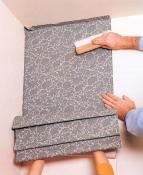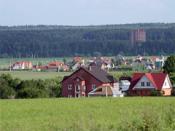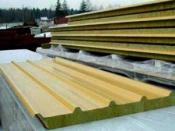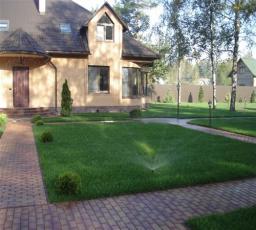Search
Login
Paving slabs in the country: the choice of material, how to choose and do it yourself
Recently, more and more attention has been paid to the refinement of the territory adjacent to the house, be it a summer house or a cottage. Moreover, preference is given to the arrangement of paths. And this is not surprising, because with the help of paths you can divide the entire site into certain zones intended for growing flowers, beds, constructing a pool, gazebo.
As a modern material focused on the construction of paths, paving slabs have the greatest distribution, which has a lot of advantages with respect to asphalt or concrete pavement. However, the operational life of the tile directly depends on a competent approach to the selection of the product and the installation.
Content
- Advantages and disadvantages of paving slabs
- How to choose the paving slabs video
- Types of paving slabs, their advantages video
- Tools required for tile installation
- Preparatory work before laying the tiles video
- Laying tiles video
Advantages and disadvantages of paving slabs
- A wide range of colors and a variety of geometric sizes allow you to create original drawings in the process of styling;
- Installation is carried out in such a way that the seams between the tiles form their own drainage system, ensuring the absence of puddles on the paths;
- Tiles are made from environmentally friendly materials, so in hot weather there is no emission of harmful substances into the atmosphere;
- Manual laying eliminates the involvement of special equipment, so installing paving slabs for a summer residence is inexpensive;
- Damage to one tile during operation does not require replacement of the entire pavement, but only requiring the replacement of an element;
- Durability (25-30 years);
- Relatively high cost.
However, the cost of the tile depends on the impending load on the path, the brightness of the stain, the relief of the tile, so choosing an option suitable for certain conditions of use will not be difficult.
How to choose the paving slabs?
Of course, cost is of paramount importance, since cheap tiles are unlikely to last longer than 1-2 years. In addition, high-quality paving slabs for summer cottages must meet the following criteria:
- The shape of the tile must have the correct geometric proportions.
- Coloring should affect not only the top layer of the front tile, but also the entire thickness of the tile without any inclusions.
- The homogeneity of the structure is the absence of air pockets, cracks.
- When hitting each other, the tile should emit a sonorous sound, indicating compliance with the process.
When choosing a tile, you should also pay attention to its dimensions:
- Tile of small forms, but with a thickness of more than 6 cm, ideally withstands high loads, therefore, it is most suitable for the arrangement of automobile, environmental garage sites;
- Tiles up to 6 cm are used for pedestrian paths not intended for the entry of vehicles.
And, lastly, it is necessary to purchase paving slabs with a 5% margin for unforeseen circumstances.
Types of paving slabs, their advantages
Innovative technologies do not stand still, so every year the variety of tiles is expanding, which differs in the composition of the components used, the production method, various geometric dimensions, scope, and, of course, cost. Today, the most popular types of paving slabs for summer cottages include:
1. Cement and sand tiles are produced in 2 ways:
Vibro-pressing of semi-dry mixtures occurs in an automated way. Tile thickness from 6 cm.
Pros and cons:
- Dimensional accuracy of all tiles;
- High durability of a product;
- Frost resistance;
- Low water absorption;
- Excellent wear resistance
- Chemical resistance;
- Long service life;
- Limited color spectrum (gray, red);
- A rough, flat surface without any ornament;
- High price.

Vibrocasting is carried out almost manually. The thickness of the manufactured tiles is 3-6 cm.
Pros and cons:
- Smooth surface;
- The presence of a diverse ornament;
- Wide color gamut;
- The possibility of violation of geometric parameters;
- Low frost resistance;
- Fragility;
- Low strength;
- The price is slightly lower than vibro-pressed tiles.

2. Clinker tiles are obtained by firing special grades of clay at high temperature. Tile thickness varies between 1-2.5 cm
Pros and cons:
- Frost resistance;
- High mechanical strength;
- Uniformity of structure and color;
- Excellent wear resistance
- Long preservation of the original color;
- Wide color range;
- Resistance to chemical elements;
- Durability;
- The cost is several times higher than the price of cement-sand tiles.

3. Rubber tile is a combination of rubber compound, EPDM filler and polyurethane.
Pros and cons:
- A variety of colors;
- Excellent noise insulation performance;
- Frost resistance;
- Low cost;
- Violation of the integrity of the tile when exposed to sharp objects.

4. Polymer-sand (plastic) tiles are made by melting on the basis of sand, polymers, dyes under the influence of temperatures above 250C, and then by pressing.
Pros and cons:
- Plastic;
- High density;
- Uniformity of structure, color;
- Resistance to mechanical, chemical attack;
- Decorativeness;
- High frost resistance;
- Impact resistance;
- Increased UV Resistance.
- Durability;
- The average price range relative to other types of paving slabs.

5. Granite tiles made of natural stone.
Pros and cons:
- Durability;
- Wear resistance;
- Frost resistance;
- Impact resistance;
- High cost, significantly exceeding the cost of cement-sand and clinker tiles.

Thus, vibropressed, clinker, plastic, granite tiles are ideal for paving tracks, areas designed to withstand high loads.
It is quite possible to give the path an attractive appearance with the help of vibrocast or polymer-sand paving slabs.
Rubber tiles are ideal for arranging space near the pool, or in front of the house.
Based on the foregoing, the most acceptable option in terms of cost and quality characteristics for the improvement of any part of the house territory is plastic paving slabs for summer cottages.
Tools required for tile installation
The following set will come in handy:
- manual tamper;
- curbstone;
- cement-sand mixture;
- crushed stone;
- dry plaster;
- geotextiles;
- sand;
- channel;
- broom;
- rake;
- watering can with a diffuser;
- rubber mallet;
- master OK;
- building level;
- cord;
- paving slabs.
Preparatory work before laying the tiles
The quality of the installation performed depends on the correctness of the preliminary work, so it’s worthwhile to responsibly approach this stage. It is necessary: 
- To remove the sod, delving into the soil by 20 cm, while removing the remaining roots and flying seeds of the plants.
- Plan along and across the bottom of the trench of the future path, making a slope of about 5% from the house to the road for outflow of water.
- Tamp the bottom of the trench.
- On both sides of the main trench, dig separate grooves for the curb stone, tamp, fill it with sand 5 cm.
- Dilute the thick cement mortar and lay in the grooves, then install the curb stone and press it a little into the cement for better setting.

- Cover the bottom of the main trench with geotextiles.
- To fill up with a layer of crushed stone, about 10 cm, to compact.
- Pour sand to a height of 5 cm, moisten and compact, walk with a channel to level the surface.
- An alternative layer - the use of 10 cm concrete screed is necessary when parking vehicles at the site.
- Pour a 10 cm layer of sand, moisten, tamp and level.
At this stage, preliminary work on laying paving slabs + in the country is completed.
Laying tiles

- The laying process is done on its own, so as not to disturb the foundation prepared for paving.
- The first row is laid parallel to the plane.
- Each laid tile is rammed with a rubber mallet.
- Between the tiles it is necessary to make a gap of 2-3 mm for the drainage system. Here you can use crosses for laying regular tiles.
- Obstacles encountered on the way, for example, in the form of a fountain, are dispensed with whole tiles, and at the end they trim and then fit the necessary tiles.

- The gaps between the tiles must be carefully covered with sand, or with dry plaster.
- At the end of the work, the tile must be cleaned with a broom from excess sand and washed off with water. When washing sand in some joints, it is necessary to pour it and rinse it off again with water.

Guided by such a small instruction, laying paving slabs in the country will not be difficult even for an unprepared person. Of course, special attention should be paid to the selection of the necessary tiles and the quality of the preparatory work, since it is they that have a greater impact on the finished look of the laid paving slabs with their own hands.





